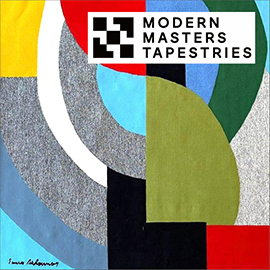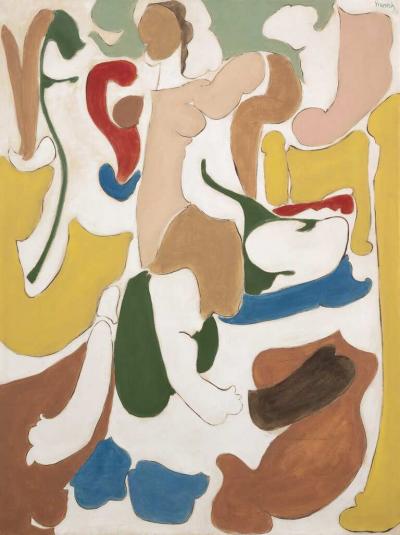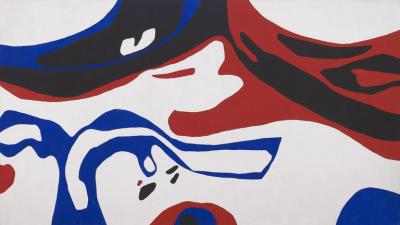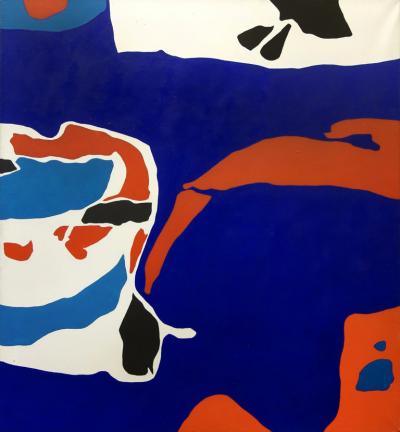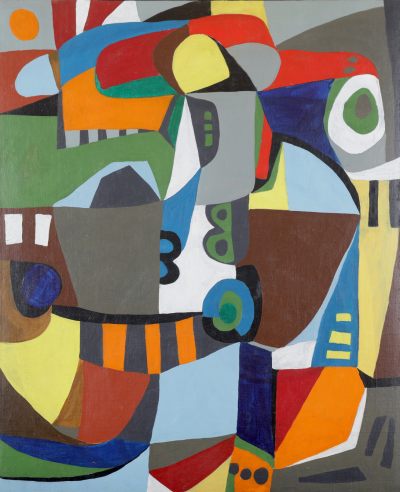George Vranesh
American, 1926 - 2014
Renowned for his mastery of color and unwavering commitment to modernist exploration, George Vranesh, born in Minnesota in 1926, carved a distinctive path throughout his artistic journey. After serving in the U.S. Navy, Vranesh delved into the vibrant artistic milieu at the Art Students League in New York during the mid-fifties. Under the guidance of Will Barnet, Vranesh assimilated the principles of modernism, resulting in flattened forms and boldly colored abstractions that became central to his evolving style.
Will Barnet's pedagogical approach, emphasizing both the study of art history and formal experimentation, profoundly influenced Vranesh. The artist skillfully merges Amédée Ozenfant's purist theories with Hans Hofmann's "push-pull" color concepts, achieving a harmonious interplay of geometry and color in vibrant abstract compositions. Vranesh's adept application of these theoretical foundations demonstrates a deep understanding, culminating in a distinctive and personal artistic expression.
An additional layer to Vranesh's artistic perspective is his academic background in anthropology, culminating in an MA degree from the University of Iowa. This academic journey fueled his fascination with diverse cultures, reflected in his artwork. The interlocking organic forms, blurring the boundaries between positive and negative space, reveal affinities with the Indian Space Painters, a group influenced by Native American art. While Vranesh's titles from the fifties allude to modern life, the essence of his paintings carries an intrinsic connection to cultural exploration.
From 1959 to 1965, Vranesh's annual sojourns to Alaska became a wellspring of inspiration for his Alaskan Horizons series. These paintings abstracted the mesmerizing Alaskan landscape into vivid color forms, resonating with the hues of native Alaskan art. Works like Terror Bay and Alaska True Blue bear titles reflective of remote Alaskan locations, showcasing Vranesh's profound relationship with nature and place. Beyond his artistic endeavors, Vranesh expanded his expertise as a printmaker and a dedicated teacher. His exhibitions spanned influential locales, including New York, Anchorage, and Newport, leaving an indelible mark on the contemporary art scene.
Will Barnet's pedagogical approach, emphasizing both the study of art history and formal experimentation, profoundly influenced Vranesh. The artist skillfully merges Amédée Ozenfant's purist theories with Hans Hofmann's "push-pull" color concepts, achieving a harmonious interplay of geometry and color in vibrant abstract compositions. Vranesh's adept application of these theoretical foundations demonstrates a deep understanding, culminating in a distinctive and personal artistic expression.
An additional layer to Vranesh's artistic perspective is his academic background in anthropology, culminating in an MA degree from the University of Iowa. This academic journey fueled his fascination with diverse cultures, reflected in his artwork. The interlocking organic forms, blurring the boundaries between positive and negative space, reveal affinities with the Indian Space Painters, a group influenced by Native American art. While Vranesh's titles from the fifties allude to modern life, the essence of his paintings carries an intrinsic connection to cultural exploration.
From 1959 to 1965, Vranesh's annual sojourns to Alaska became a wellspring of inspiration for his Alaskan Horizons series. These paintings abstracted the mesmerizing Alaskan landscape into vivid color forms, resonating with the hues of native Alaskan art. Works like Terror Bay and Alaska True Blue bear titles reflective of remote Alaskan locations, showcasing Vranesh's profound relationship with nature and place. Beyond his artistic endeavors, Vranesh expanded his expertise as a printmaker and a dedicated teacher. His exhibitions spanned influential locales, including New York, Anchorage, and Newport, leaving an indelible mark on the contemporary art scene.
